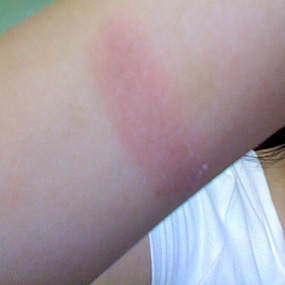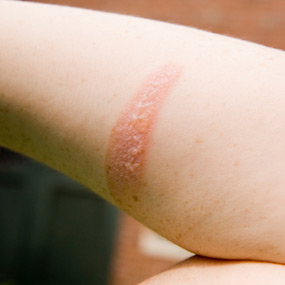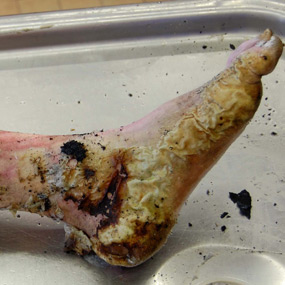Burns: Types, Treatments, and More
Overview
Burns are among the most common household injuries, especially in children. The term “burn” means more than the burning sensation associated with this injury. Burns are characterized by severe skin damage in which many of the affected cells die. Depending on the cause and degree of injury, most people can recover from burns without serious health consequences. More serious burns require immediate emergency medical care to prevent complications and death.
Part 2 of 8
Burn Levels
There are three primary types of burns: first-, second-, and third-degree. Each degree is based on the severity of damage to the skin, with first degree being the most minor and third degree being the most severe. Damage includes:
There is also technically a fourth-degree burn. In this type, the damage of third-degree burns extends beyond the skin into tendons and bones.
Burns have a variety of causes, including:
The type of burn is not based on the cause of it. Scalding, for example, can cause all three burns, depending on how hot the liquid is and how long the skin makes contact. Chemical and electrical burns warrant immediate medical attention because they can affect the inside of the body — even if skin damage is minor.
Part 3 of 8
First-Degree Burn

First-degree burns cause minimal skin damage. They are also called “superficial burns” because they affect the outermost layer of skin. Signs of a first-degree burn include:
Since this burn affects the top layer of skin, the signs and symptoms disappear once the skin cells shed. First-degree burns usually heal within three to six days. Still, you should see your doctor if the burn affects a large area of skin (more than three inches), and if it’s on your face or a major joint.
First-degree burns are mostly treated with home care. Healing time may be quicker if you treat the burn sooner. To treat this type, you can:
Make sure you don’t use ice, as this may make the damage worse. Never apply cotton balls to a burn because the small fibers can stick to the injury and increase the risk of infection. Also, avoid home remedies like butter and eggs as these are not proven to be effective.
Part 4 of 8
Second-Degree Burn

Second-degree burns are more serious because the damage extends beyond the top layer of skin. This type of extensive damage causes the skin to blister and become extremely red and sore. Some blisters pop open, giving the burn a wet appearance.
Due to the delicate nature of such wounds, frequent bandaging is required to prevent infection. This also helps the burn heal quicker. Some second-degree burns take longer than three weeks to heal, but most heal within two to three weeks. The worse the blisters are, the longer the burn will take to heal. In some severe cases, skin grafting is required to fix the subsequent damage. Skin grafting borrows healthy skin from another area of the body and replaces it at the site of the burned skin.
As with first-degree burns, avoid cotton ball wraps and questionable home remedies. You can generally treat a mild second-degree burn by:
However, seek emergency medical treatment if burns affect a widespread area of the:
Part 5 of 8
Third-Degree Burn

Third-degree burns are the worst burns. They cause the most damage, extending through every layer of skin. The damage can even reach the bloodstream, major organs, and bones, which can lead to death.
There is a misconception that third-degree means most painful. With this type of burn, the damage is so extensive that you may not feel pain because your nerves are damaged. Depending on the cause, third-degree burns cause the skin to look:
Never attempt to self-treat a third-degree burn.Call 911 immediately. While you’re waiting for medical treatment, raise the injury above your heart. Don’t get undressed, but make sure no clothing is stuck to the burn. There is no set healing timeline for third-degree burns.
Part 6 of 8
Complications
Third-degree burns carry the most risk for complications, such as infections, blood loss, and shock. Still, this doesn’t mean that minor first and second-degree burns can’t cause complications. All burns carry the risk of infections because bacteria can enter broken skin. Sepsis, or a bloodstream infection, can occur in the most severe cases. This can lead to shock or even death.
Tetanus is another possible complication with burns of all levels. Like sepsis, tetanus is a bacterial infection. It affects the nervous system, eventually leading to problems with muscle contractions. As a rule of thumb, every member of your household should receive updated tetanus shots every five years to prevent this type of infection.
Severe burns also carry the risk of hypothermia and hypovolemia. Hypothermia is characterized by dangerously low body temperatures. While this may seem like an unexpected complication of a burn, the condition is actually prompted by excessive loss of body heat from an injury. Hypovolemia, or low blood volume, occurs when your body loses too much blood from a burn.
Scars are a complication of all burns. Severe burns may cause keloids, which are discolored areas of scar tissue on the skin. While keloids aren’t harmful in themselves, they can be bothersome. The appearance of scar tissue can worsen with sun exposure, so be sure to wear adequate sunscreen on any exposed areas.
Part 7 of 8
Preventing All Levels of Burns
The best way to fight burns is to prevent them from happening altogether. Certain jobs put you at a greater risk for burns, but the fact is that most of them happen at home. Infants and young children are the most vulnerable to burns. Here are some tips for the preventive measures you can take:
It’s also important to have a fire escape plan and to practice it with your family once a month. In the event of a fire, make sure to crawl underneath smoke. This will minimize the risk of passing out and becoming trapped in a fire.
Part 8 of 8
Outlook for Burns
When properly and quickly treated, the outlook for first and second-degree burns is good. These burns are also less prone to scarring. The key is to minimize further damage and infection. Extensive damage from severe second-degree and third-degree burns can lead to problems in deep skin tissues, bones, and organs. Patients may require:
While it’s important to gain adequate physical treatment from burns, don’t forget to find help for your emotional needs. There are support groups available for burn victims, as well as certified counselors.
No comments:
Post a Comment